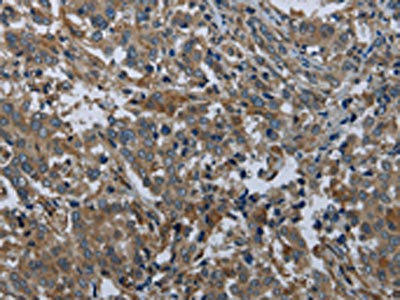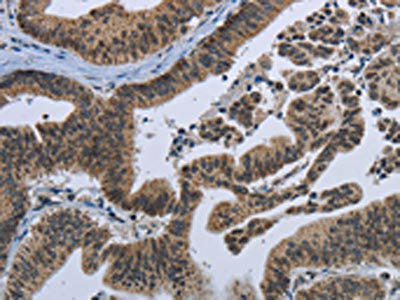Description
| Antibody Name: | EPHA10 Antibody (PACO16262) |
| Antibody SKU: | PACO16262 |
| Size: | 50ul |
| Host Species: | Rabbit |
| Tested Applications: | ELISA, IHC |
| Recommended Dilutions: | ELISA:1:1000-1:2000, IHC:1:25-1:100 |
| Species Reactivity: | Human, Mouse |
| Immunogen: | Fusion protein of human EPHA10 |
| Form: | Liquid |
| Storage Buffer: | -20°C, pH7.4 PBS, 0.05% NaN3, 40% Glycerol |
| Purification Method: | Antigen affinity purification |
| Clonality: | Polyclonal |
| Isotype: | IgG |
| Conjugate: | Non-conjugated |
 | The image on the left is immunohistochemistry of paraffin-embedded Human liver cancer tissue using PACO16262(EPHA10 Antibody) at dilution 1/20, on the right is treated with fusion protein. (Original magnification: x200). |
 | The image on the left is immunohistochemistry of paraffin-embedded Human gastic cancer tissue using PACO16262(EPHA10 Antibody) at dilution 1/20, on the right is treated with fusion protein. (Original magnification: x200). |
| Background: | Ephrin receptors, the largest subfamily of receptor tyrosine kinases (RTKs), and their ephrin ligands are important mediators of cell-cell communication regulating cell attachment, shape, and mobility in neuronal and epithelial cells |
| Synonyms: | EPH receptor A10 |
| UniProt Protein Function: | EphA10: Receptor for members of the ephrin-A family. Binds to EFNA3, EFNA4 and EFNA5. Belongs to the protein kinase superfamily. Tyr protein kinase family. Ephrin receptor subfamily. 3 isoforms of the human protein are produced by alternative splicing. |
| UniProt Protein Details: | Protein type:Kinase, protein; Protein kinase, tyrosine (receptor); Membrane protein, integral; Protein kinase, TK; EC 2.7.10.1; TK group; Eph family Chromosomal Location of Human Ortholog: 1p34.3 Cellular Component: plasma membrane Molecular Function:protein binding Biological Process: ephrin receptor signaling pathway |
| NCBI Summary: | Ephrin receptors, the largest subfamily of receptor tyrosine kinases (RTKs), and their ephrin ligands are important mediators of cell-cell communication regulating cell attachment, shape, and mobility in neuronal and epithelial cells (Aasheim et al., 2005 [PubMed 15777695]). See MIM 179610 for additional background on Eph receptors and ephrins.[supplied by OMIM, Mar 2008] |
| UniProt Code: | Q5JZY3 |
| NCBI GenInfo Identifier: | 476007830 |
| NCBI Gene ID: | 284656 |
| NCBI Accession: | Q5JZY3.2 |
| UniProt Secondary Accession: | Q5JZY3,Q6NW42, A4FU89, J3KPB5, |
| UniProt Related Accession: | Q5JZY3 |
| Molecular Weight: | 97,293 Da |
| NCBI Full Name: | Ephrin type-A receptor 10 |
| NCBI Synonym Full Names: | EPH receptor A10 |
| NCBI Official Symbol: | EPHA10 |
| NCBI Protein Information: | ephrin type-A receptor 10 |
| UniProt Protein Name: | Ephrin type-A receptor 10 |
| Protein Family: | Ephrin type-A receptor |
| UniProt Gene Name: | EPHA10 |
| UniProt Entry Name: | EPHAA_HUMAN |
| Secondary Antibody |
| Anti-HRP Goat Anti-Rabbit IgG (H+L) Antibody (CABS014) |
| Recommended Products |
| Anti-FITC Goat Anti-Rabbit IgG (H+L) Antibody (CABS011) |
| Anti-HRP-conjugated Beta Actin Antibody (CABC028) |






